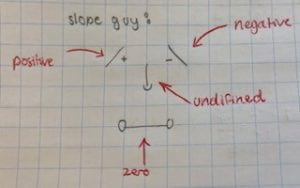This week we started a new math unit on slopes and graphs. So far we have learned many things such as how to calculate the slope of a line, different slopes, different equations, and so much more. Two of the main things that I learned this week are the four different kinds of slopes and I also learned how to calculate a slope of a line that passes through two sets of given points.
The four different kinds of slopes are positive, negative, zero, and undefined.
in class we learned about one method to help us identify whether a slope is either positive, negative, zero, or undefined. That method is called slope guy.
The next thing I learned was how to calculate a slope of a line that passes through two set of given points without using graph paper. You do this by finding the difference between them.
The two given sets of points that we’re going to use is (5,-1) and (-2,3)
First, we’re going to find the difference between the y values which are -1 and 3. That would be +4
Next, you have to find the difference between the x values which are 5 and -2. That would be +7
Lastly, you would turn it into a fraction and you always have to remember to make it so that it is always rise/run and y/x. because the difference between the Y values was 4 and the difference between the X values was 7 the fraction would be 4/7
Final answer: 4/7













